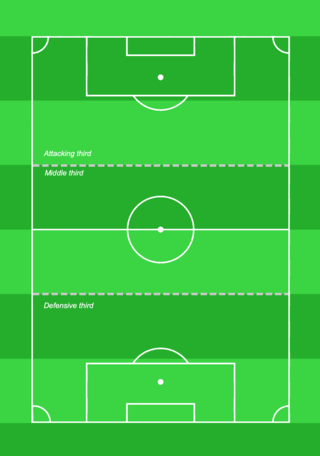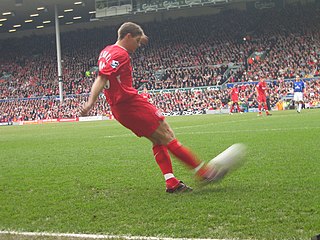
A kick is a physical strike using the leg, in unison usually with an area of the knee or lower using the foot, heel, tibia (shin), ball of the foot, blade of the foot, toes or knee. This type of attack is used frequently by hooved animals as well as humans in the context of stand-up fighting. Kicks play a significant role in many forms of martial arts, such as capoeira, kalaripayattu, karate, kickboxing, kung fu, MMA, Muay Thai, pankration, pradal serey, savate, sikaran, silat, taekwondo, vovinam, and Yaw-Yan. Kicks are a universal act of aggression among humans.

In many team sports that involve scoring goals, the goalkeeper is a designated player charged with directly preventing the opposing team from scoring by blocking or intercepting opposing shots on goal. Such positions exist in bandy, rink bandy, camogie, association football, Gaelic football, international rules football, floorball, handball, hurling, field hockey, ice hockey, roller hockey, lacrosse, ringette, rinkball, water polo, and shinty, as well as in other sports.

This is a general glossary of the terminology used in the sport of cricket. Where words in a sentence are also defined elsewhere in this article, they appear in italics. Certain aspects of cricket terminology are explained in more detail in cricket statistics and the naming of fielding positions is explained at fielding (cricket).

A strike is a directed, forceful physical attack with either a part of the human body or with a handheld object, intended to cause blunt or penetrating trauma upon an opponent.

Team tactics as well as individual skills are integral for playing association football. In theory, association football is a very simple game, as illustrated by Kevin Keegan's namely assertion that his tactics for winning a match were to "score more goals than the opposition". Tactical prowess within the sport is nonetheless a craftsmanship of its own, and one of the reasons why managers are paid well on the elite level. Well-organised and ready teams are often seen beating teams with more skillful players on paper. Manuals and books generally cover not only individual skills but tactics as well.

Didier Yves Drogba Tébily is an Ivorian former professional footballer who played as a striker. He is the all-time top scorer and former captain of the Ivory Coast national team. He is best known for his career at Chelsea, for whom he has scored more goals than any other foreign player and is currently the club's fourth highest goal scorer of all time. Drogba was named Chelsea's greatest ever player in a poll of 20,000 fans conducted by Chelsea FC Magazine in 2012, and he was also named in the Chelsea team of the 2010–2020 decade by Chelsea's fans in 2020. Regarded as one of the greatest African players of all time, he was noted for his physical strength, speed, ability in the air, powerful and accurate strikes, and ball retention. Drogba was named African Footballer of the Year twice, winning the award in 2006 and 2009.

The front kick in martial arts is a kick executed by lifting the knee straight forward, while keeping the foot and shin either hanging freely or pulled to the hip, and then straightening the leg in front of the practitioner and striking the target area. It is desirable to retract the leg immediately after delivering the kick, to avoid the opponent trying to grapple the leg and to return to stable fighting stance.
In tennis, there are a variety of types of shots which can be categorized in various ways. The grip you place on will help you have different types of shots, the lower your grip means that the ball is most likely going to be a ground stroke. According to William T. Tilden, "All tennis strokes, should be made with the body' at right angles to the net, with the shoulders lined up parallel to the line of flight of the ball." The serve is the opening shot of a point. Groundstrokes are hit after the ball has already bounced, and can be either forehands or backhands depending on which direction the racket is swung relative to the body. A lob is a groundstroke hit well over the head of an opponent who is positioned at the net. A passing shot is a groundstroke that is hit out of reach of an opponent at the net far to his left or right. A cross-court shot is a shot hit from the left side of one player's court to the left side of the other player's court, so that it crosses the lengthwise centerline of the court. A down-the-line shot is one that is hit more or less parallel to, and near to, one of the sidelines, so that it never crosses the centerline.

The 2005 Football League Cup final was a football match played between Liverpool and Chelsea on 27 February 2005 at the Millennium Stadium, Cardiff. It was the final match of the 2004–05 Football League Cup, the 45th season of the Football League Cup, a football competition for the 92 teams in the Premier League and Football League. Liverpool were appearing in their tenth final; they had previously won seven and lost two while Chelsea were appearing in the final for the fourth time. They had previously won twice and lost once.

Rugby union is a contact sport that consists of two teams of fifteen players. The objective is to obtain more points than the opposition through scoring tries or kicking goals over eighty minutes of playing time. The play is started with one team drop-kicking the ball from the halfway line towards the opposition. The rugby ball can be moved up the field by either carrying it or kicking it. However, when passing the ball it can only be thrown laterally or backward. The opposition can stop players moving up the field by tackling them. Only players carrying the ball can be tackled and once a tackle is completed the opposition can compete for the ball. Play continues until a try is scored, the ball crosses the side line or dead-ball line, or an infringement occurs. After a team scores points, the non-scoring team restarts the game at the halfway with a drop kick toward the opposition. The team with the most points at the end wins the game.
This is a general glossary of the terminology used in the sport of rugby union. Where words in a sentence are also defined elsewhere in this article, they appear in italics.
Rugby league football has accrued considerable jargon to describe aspects of the game. Many terms originate in the Laws of the Game. Some aspects of the game have more than one term referring to them. Different terms have become popularly used to describe an aspect of the game in different places, with notable differences between the Northern and Southern Hemispheres.

This list is an alphabetical glossary of Australian rules football terms, jargon and slang. While some of these entries are shared with other sports, Australian rules football has developed a unique and rich terminology.

In association football, shooting is hitting the ball in an attempt to score a goal. It is usually done using the feet or head. A shot on target or shot on goal is a shot that enters the goal or would have entered the goal if it had not been blocked by the goalkeeper or another defensive player.

In association football, a cross is a medium- to-long-range pass from a wide area of the pitch towards the centre of the field near the opponent's goal. Specifically, the intention of a cross is to directly bring the ball into the box from an angle that allows the attacking forwards to more easily aim for goal with their head or feet. Crosses are generally airborne (floated) to clear nearby defenders, but can also be hit with force along the ground (drilled). It is a quick and effective move.

The laws of Rugby Union are defined by World Rugby and dictate how the game should be played. They are enforced by a referee, generally with the help of two assistant referees.

A footbag is a small, round bag usually filled with plastic pellets or sand, which is kicked into the air as part of a competitive game or as a display of dexterity. "Hacky Sack" is the name of a brand of footbag popular in the 1970s, which has since become a generic trademark.
A chip, also known as a lob, is a shot in which the ball is kicked from underneath with accuracy but with less than maximum force, to launch it high into the air in order either to pass it over the heads of opponents or to score a goal over the goalkeeper. Chip shots usually have backspin, otherwise they are usually considered a lob.

A header is a technique that is used in association football to control the ball using the head to pass, shoot, or clear. This can be done from a standing, jumping, or diving position. Heading is a common technique and is used by players in practically every match. Although a useful technique in football, heading carries significant health risks, particularly to the brain, and governing bodies have taken measures to address these risks.
This glossary provides definitions and context for terminology related to, and jargon specific to, the sport of pickleball. Words or phrases in italics can be found on the list in their respective alphabetic sections.
















